Archive for the ‘Endwar’ Category
Entry 348 — Endwar Enters the Taxonomy Discussion
Saturday, January 15th, 2011
Endwar had such intereseting comments to contribute to the discussion going on at Geof Huth’s blog concerning my A Preliminary Taxonomy of Poetry that I decided, with his permission, to give them a second printing here, with a few stray comments of mine to follow:
On mathematical poetry and mathematics: I’m not sure I agree completely with anyone here. It seems to me that in a mathematical poem one sees a mathematical operation with words (usually) operating in a metaphorical way (thus the poetry enters). That said, the mathematical operations involved are usually well-defined for numbers, but not for various words and concepts. “3+1=2” is something everyone (is taught to) agrees on in a literal way, and it follows from the definitions of each number and the signs “+” and “=”. The statement “candy cane + child = happiness” is also probably pretty generally understood, but not with the same level of definiteness (or definition, as per the previous sentence) as the numerical example earlier. You could write “candy cane + child = obesity”, which would probably also be understood, but because of the metaphorical nature of the math, you can’t conclude (via the law of substitution) that “happiness = obesity” (though some may point out the phrase “fat, dumb, and happy”, which could then lead us to conclude “happiness = obesity = stupidity” . . . You can see, then where the multiple meanings of words (bifurcations of meaning, to throw in another mathematical metaphor popular in some at one time trendy lit-crit circles)) can lead.)
I would argue that a mathematical poem is a statement that represents a mathematical operation on the words involved, but which isn’t necessarily one that can be checked the way mathematical statements with numbers can be. I will even go one step further and assert that one can create a mathematical poem that is mathematically wrong but which still makes a metaphorical point. I have done this using matrix multiplication – a 2×2 matrix times a 2×1 vector is set equal to a 3×1 vector. That’s not something you can do with real number (or even imaginary number) math, but I think it works as a poem.
Written mathematics is inherently visual, not verbal>: I can grant Bob’s point that “3-1=2” is visually not interesting, and furthermore it hardly matters what font is used. It does matter a bit what numbers are used – roman numerals will say “III-I=II”, and binary says “11-1=10”, and ternary says “10-1=2”, which are all the same numerically. But it becomes evident for large numbers that roman numerals are unwieldy for calculating, and we are used to the decimal number system, so the non-decimal numbers need cumbersome subscripts or context to be read as intended. I would argue, though, that the real test of whether we have something verbal versus something visual is whether the statement can be read aloud. Again “Three minus one equals two,” is pretty straightforward, but that is merely because of the simplicity of the expression. Try reading, say, a passage out of the middle of J.D. Jackson’s <I>Classical Electrodynamics</I> or any other graduate physics or mathematics text, and it will be immediately obvious why these equations aren’t written out in words and why mathematicians and scientists do nearly all their professional discussions with slides or in the presence of a blackboard. And even if one does manage to put the text purely into words read aloud, you will find nobody in the audience who will understand what has been said who hasn’t at least written down some equations or a drawing as a guide. One of the most tedious reading experiences I had was a few pages out of an algebra text written by Leonhard Euler, who felt it was necessary to write down an equation and then repeat the equation in words, such as:
“E=mv ²/2The kinetic energy is equal to half the product of the mass and the square of the velocity.” This continues for page after page.
If you’re still not convinced, show me how to do read calculus aloud and make it intelligible. Two pages minimum.
Because the visual representation is integral to the intelligible communication of all but the simplest mathematics, I would argue that mathematics is inherently visual language, and that by extension, mathematical poetry is also inherently visual poetry. The visual poem may still not depend on which font is used (though I have examples where that is the case as well), but it still can’t be read aloud and have the same meaning, because it will not then register as mathematical.
On hypertext: I think Bob is right that hypertext is not necessarily computer poetry, though the number of sequences need not be infinite. There are primitive hypertexts preceding the web, if not the computer, perhaps the most literarily respectable being Julio Cortazar’s 1963 novel Hopscotch, or the near equivalent in the many children’s books where the reader gets to decide the adventure, where one reads the first page and at the bottom of each page one sees a sentence like “If Joe enters the gate, go to page 23. If Joe continues down the road, go to page 42,” and continues until one reaches an ending. (I suppose one can write out a tree or flow chart to describe the plot and then label it some sort of finite state machine or finite automaton, which is sort of a representation of a simple computer, but I digress.) The point that I am agreeing with Bob is that a hypertext does not necessarily require a computer, though using a computer and particularly one with html, greatly facilitates the process. Hypertext is thus distinct from code poetry like that which might be like that of Sondheim (or Jim Andrews or Ted Warnell (poems by Nari)). And just as there is a difference between mathematics with numbers and mathematical poetry, a poem written in/with computer code need not be an actually compileable program. There are of course many other approaches to poetry using a computer (starting with using a text editor to pound out cantos), for which I will refer the reader to the books of Jorge Luiz Antonio, who is trying to catalog them all (to see his long list of links to Brfazilian digital poetry samples, see http://vispo.com/misc/BrazilianDigitalPoetry.htm).
BTW, for another experience of the difference between computer code and a written document, try viewing the source code of this web page (or the dbqp blog itself), and contrast the instructions for the computer (the part read and understood by the machine) and the human readable part.
endwar
First a very quick acceptance, I think, with Endwar’s definition of mathematical poetry, except that I’d use different words to define it than he has: mathematical poetry is poetry that carries out mathematical operations, metaphorically, on non-mathematical terms. This is, I believe, the first time I’ve accepted that the operations are metaphorical, as Gregory St. Thomasino tried to convince me six months or so ago. My trouble (still) is that the operations seem actual to me–the sun really does multiply a field to get flowers!
Then my two comments at Geof’s blog:
Entry 57 — Minimalist Poem Sequence by Endwar
Monday, December 28th, 2009
#699 through #715 of my old blog are all about the anthology of visio-textual art Crag Hill and I co-edited ten years or so ago, Writing To Be Seen. I do an entry on one piece by each of the contributors and a few miscellaneous ones. Rather than run them again here, I’m going to put them all together as an essay in the Pages section to the right. It’ll start off being a jumble but eventually will get organized, as with several still-disorganized pages.
To make this entry more than just an announcement, here is the sequence of minimalist permutational infraverbal poems (subverse, in his jargon, which I believe he got from his and my pal, Will Napoli) by Endwar that I featured in #716:
Oh, and a second announcement: today I began, and almost completed, my column for the next issue of Small Press Review. No big deal except that it’s a chore I’ve tried to get to every day for at least two months. I feared I’d never do it! Really. I hope my getting to it means I’ll start being at least slightly productive again. There’s so much I need to get done.
.
. add
. read
. a lie
. realize
. a verb
. reverb
. a mind
. remind
. a vision
. revision
. apt
. repeat
. a sign
. resign
. all
. real
.
Oh, and a second announcement: today I began, and almost completed, my column for the next issue of Small Press Review. No big deal except that it’s a chore I’ve tried to get to every day for at least two months. I feared I’d never do it! Really. I hope my getting to it means I’ll start being at least slightly productive again. There’s so much I need to get done.
Entry 39 — 3 by Endwar
Thursday, December 10th, 2009
They’re from #674.
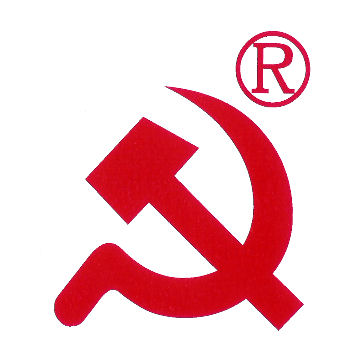 Communist Evolution
Communist Evolution
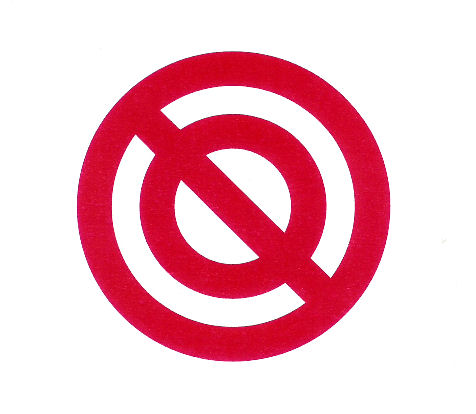 NoNo
NoNo
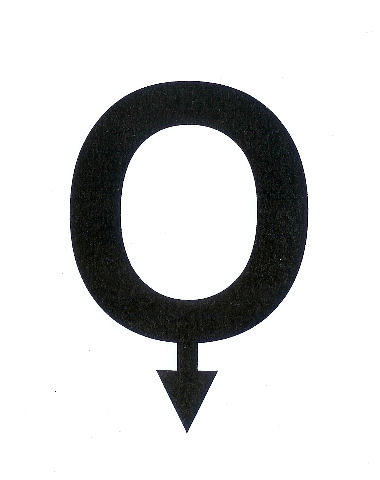 Transgender
Transgender
#673 had two poems by John Elsbergs from his Runaway Spoon Press book, Broken Poems for Evita. One was this:
RAISING EVA (Or, the myth of art and politics) L EVITA tio nis th EPRE fer RED al TERN at ivefor thosewhona t UR ALLY S inK
And that’s it for this entry. (Am I feeling more worn out than ever for no reason? Yes.)
Entry 31 — Old Blog Entries 663 through 670
Wednesday, December 2nd, 2009
In #663, I presented my Odysseus Suite–but the reproduction is too crude for me to re-post it here. My next entry featured this, by Endwar:
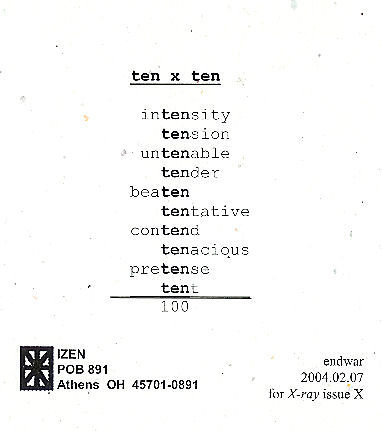 As I announced when I first posted this, I am hoping to publish an anthology of mathematical poems, like this one, so if you have one or know of one, send me a copy of it, or tell me about it.
As I announced when I first posted this, I am hoping to publish an anthology of mathematical poems, like this one, so if you have one or know of one, send me a copy of it, or tell me about it.
#665 had this by Marton Koppany, which I have to post here because it was dedicated to ME:
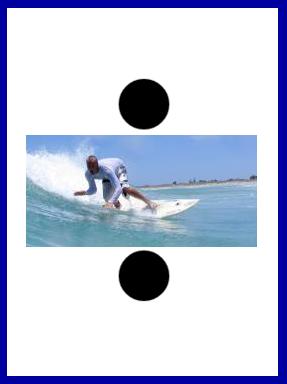
Hey, it’s mathematical, too. The next entry, whose number I fear to state, concerned this:

This is from Typewriter Poems, an anthology published by Something Else Press and Second Aeon back in 1972. It’s by Alison Bielski, An English woman born in 1925 whose work I’m unfamiliar with. I find this specimen a charmer . . . but am not sure what to make of it. Three lines, as in the classic haiku. The middle one is some sort of filter. Is “n” the “n” in so much mathematics? If so, what’s the poem saying? And where does the night and stars Hard for me not to assume come in? Pure mathematics below, a sort of practical mathematics above? That idea would work better for me if the n’s were in the lower group rather than in the other. Rather reluctantly, I have to conclude the poem is just a texteme design. I hope someone more clever sets me right, though. (I’m pretty sure I’ve seen later visio-textual works using the same filter idea–or whatever the the combination of +’s. =’s and n’s is, but can’t remember any details.)
It was back to my lifelong search for a word meaning “partaker of artwork” in #667–but I now believe “aesthimbiber,” which I thought of in a post earlier than #667, I believe, but dropped, may be the winner of my search.
Next entry topic was about what visual poets might do to capture a bigger audience. I said nothing worth reposting on a topic going nowhere because visual poets, in general, are downright inimical to doing anything as base as trying to increase their audience. One suggestion I had was to post canonical poems along with visual poems inspired by them, which I mention because in my next entry, I did just that, posting a Wordsworth sonnet and a visual poem I did based on and quoting part of it–and don’t re-post here because of space limitations. I wrote about the two in the final entry in this set of ten old blog entries.
I don’t care whether a poem can be read aloud or not. Mathematics is written in text just as ordinary verbal material is. Text printed standardly is effectively not visual, as far as I’m concerned: it’s symbolic. So a purely mathematical poem, in my definition, would be expressed in verbal and mathematical symbols.
On further thought, it seems to me all mathematics can be read out loud. So what if one needs to see it on the page to understand it? That would be true of many linguexclusive poems, too. Even relatively simple ones. I’ve almost never understood poems I was unfamiliar with when read at poetry readings.
As for the child and candy cane, I like your reasoning, but it now seems to me you have simple shown that “candy cane + child = happiness” and “candy cane + child = obesity” are both incorrect! They should be “candy cane + child = happiness + X” and “candy cane + child = obesity +Y.” And “happiness – obesity + X – Y.”
One futher note: even if we admitted that difficult math must be seen to be understood, that would not make “candy cane + child – X = happiness” a visual poem since that particular poem would not have to be seen to be understood. That said, I can’t wait for the first mathematical poem based on mathematics you have to see on the page to understand.
–Bob